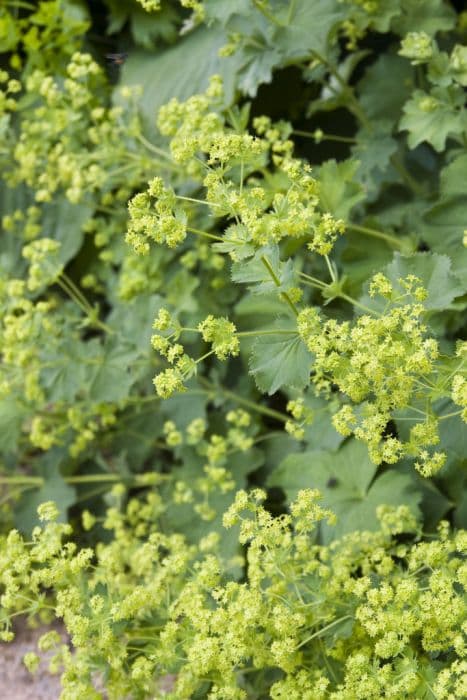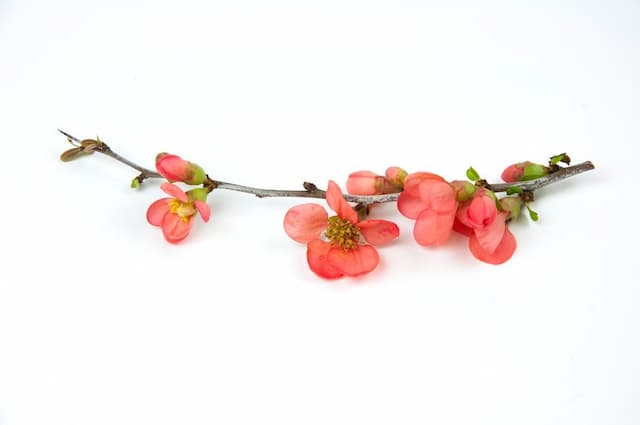Fuji cherry Prunus incisa 'Kojo-no-mai'

ABOUT
The 'Kojo-no-mai', often known as the Fuji cherry, is notable for its charming and picturesque beauty. It has a distinctive twisting growth habit, which makes the branches appear as though they are in an artistic dance, with each turn and twist providing an aesthetic that is both unique and intriguing. During the early spring, this plant is adorned with an abundance of delicate, pale pink flowers that resemble small cups. These blossoms emerge before the leaves, offering a welcome burst of color that heralds the arrival of warmer days after the dormant winter season. The leaves of the Fuji cherry are small and finely serrated, taking on a fresh, bright green hue as they unfurl. As the seasons progress, the foliage often changes to display vivid autumnal colors, offering a stunning visual display of oranges and reds before the leaves fall. Even after the foliage and flowers have gone, the contorted shape of the branches continues to captivate the eye, making the 'Kojo-no-mai' a feature of interest throughout the entire year. The overall effect of this plant's appearance is one of delicate beauty, with its springtime floral display and the intricate pattern of its branches creating a serene and picturesque scene. It is beloved for its elegant appearance and the way it brings to life the garden landscape, particularly in the early spring, with a sense of renewal and natural charm.
About this plant
 Names
NamesFamily
Rosaceae
Synonyms
Fuji Cherry, Kojo-no-mai Cherry
Common names
Prunus incisa 'Kojo-no-mai'.
 Toxicity
ToxicityTo humans
The Fuji cherry is not typically considered highly toxic to humans, but it may contain small amounts of cyanogenic glycosides, which can release cyanide when the plant parts are damaged or ingested. If ingested in large quantities, it could lead to symptoms such as headache, nausea, vomiting, abdominal pain, and dizziness. In severe cases, ingestion may lead to more serious symptoms such as difficulty breathing, increased heart rate, and potentially lethal poisoning.
To pets
The Fuji cherry may also present toxicity concerns for pets, particularly dogs and cats, as it can contain cyanogenic glycosides. If a pet ingests parts of the plant, symptoms of cyanide poisoning may include vomiting, diarrhea, abdominal pain, difficulty breathing, and lethargy. In severe cases, seizures, coma, and even death may occur. It is important to prevent pets from accessing or consuming any part of the plant.
 Characteristics
CharacteristicsLife cycle
Perennials
Foliage type
Deciduous
Color of leaves
Green
Flower color
Pink
Height
4-5 (1.2-1.5 meters)
Spread
3-4 (0.9-1.2 meters)
Plant type
Shrub
Hardiness zones
5
Native area
Japan
Benefits
 General Benefits
General Benefits- Ornamental Appeal: Prunus incisa 'Kojo-no-mai', commonly known as Fuji cherry, is highly valued for its twisted branches and picturesque growth habit, making it an excellent focal point in gardens.
- Seasonal Interest: It offers a burst of early spring flowers, with delicate pale pink to white blooms that attract pollinators and provide visual interest after the winter months.
- Compact Size: Its relatively small stature makes it suitable for smaller gardens or spaces where a full-sized cherry tree would be too large.
- Drought Resistance: Once established, Fuji cherry is relatively drought-tolerant, requiring less maintenance and watering than some other ornamental plants.
- Fall Color: In autumn, the foliage of the Fuji cherry turns to vibrant shades of red and orange, adding another season of interest in the landscape.
- Wildlife Habitat: The flowers provide an early source of nectar for bees and other pollinators, while the dense canopy can offer shelter for birds.
- Low Maintenance: Prunus incisa 'Kojo-no-mai' is known for being low maintenance, requiring minimal pruning and care once it is established in the proper growing conditions.
- Adaptability: It is capable of adapting to a variety of soil types, although it prefers well-drained soils, making it versatile for different garden designs.
 Medical Properties
Medical PropertiesThis plant is not used for medical purposes.
 Air-purifying Qualities
Air-purifying QualitiesThis plant is not specifically known for air purifying qualities.
 Other Uses
Other Uses- Floral Arrangements: The twisted branches and delicate flowers of the Fuji cherry are often used in Ikebana, the Japanese art of flower arranging, providing a unique aesthetical element to displays.
- Bonsai Specimen: Due to its small size and attractive, contorted growth habit, the Fuji cherry is a popular choice for bonsai enthusiasts.
- Garden Sculpture: Even when leafless in winter, the intricate, zig-zagging branches of the Fuji cherry can serve as a natural sculpture, adding interest to the garden.
- Photography Subject: The picturesque blossoms and form of the Fuji cherry make it a great subject for nature photography, particularly in spring.
- Educational Tool: Horticulture educators use the Fuji cherry to teach pruning techniques and discuss the impact of genetic variation on plant form.
- Backdrop for Perennials: Planted behind perennial flowers, the Fuji cherry can provide a contrasting backdrop that emphasizes the color of the blooms.
- Urban Green Spaces: Its compact size makes the Fuji cherry suitable for urban gardens and public spaces where larger trees cannot thrive.
- Habitat for Wildlife: When planted in gardens, the Fuji cherry can provide food for pollinators during its blooming season and shelter for birds and small mammals.
- Inspiration for Artists: The distinct appearance of the Fuji cherry throughout the seasons can inspire artists and be featured in paintings and other visual arts.
- Seasonal Celebrations: The Fuji cherry's early spring blossoms can be a focal point for events and celebrations that mark the change of seasons.
Interesting Facts
 Feng Shui
Feng ShuiThe plant_name is not used in Feng Shui practice.
 Zodiac Sign Compitability
Zodiac Sign CompitabilityThe plant_name is not used in astrology practice.
 Plant Symbolism
Plant Symbolism- Renewal: As a species of flowering cherry, Prunus incisa 'Kojo-no-mai', commonly known as Fuji cherry, is often associated with spring and renewal because it blooms early in the season, symbolizing new beginnings and the end of winter.
- Beauty: The delicate flowers of the Fuji cherry represent beauty and the transient nature of life, reminding us to appreciate the fleeting moments of beauty in our lives.
- Impermanence: Similar to other cherry blossoms, the Fuji cherry's short blooming period is symbolic of the impermanence of life, a key concept in Japanese culture known as 'mono no aware' which emphasizes the appreciation of the ephemeral nature of all things.
- Celebration: In Japan, the blooming of cherry blossoms is celebrated during the traditional custom of Hanami, where families and friends gather under the blooming trees for feasting and fellowship, thus Fuji cherry can symbolize festivity and community.
- Purity: The white and pink blossoms can represent purity and innocence, often used in cultural ceremonies in Japan to depict these traits.
 Water
WaterFuji cherry trees like Prunus incisa 'Kojo-no-mai' should be watered thoroughly once a week, with more frequent watering during dry conditions, making sure to soak the soil to a depth of around 12 inches. As a guideline, use about 1.5 to 2 gallons of water for young trees each time you water. For established trees, they may need around 2 to 3 gallons every two weeks, ensuring that the soil is moist but not waterlogged. During winter months when the tree is dormant, reduce watering to match the plant's lower water requirements.
 Light
LightFuji cherry trees prefer a position in full sun to partial shade to thrive. They should receive at least six hours of direct sunlight each day, though they can tolerate light afternoon shade. The ideal spot would be one that offers morning sunlight with some protection from harsh afternoon heat, especially in hotter climates.
 Temperature
TemperatureFuji cherry trees are hardy and can withstand a broad range of temperatures. They can survive in temperatures as low as -20°F and as high as 100°F, though their ideal growing conditions are between 50°F and 75°F. Extreme temperatures outside this range for prolonged periods may harm the tree.
 Pruning
PruningPruning the Fuji cherry should be done to maintain its shape, remove any dead or diseased branches, and promote healthy growth. It's best to prune in late winter or early spring before the new growth starts. Pruning once a year is typically sufficient, but any broken or damaged branches should be removed as soon as they are noticed.
 Cleaning
CleaningAs needed
 Soil
SoilThe Fuji Cherry prefers well-drained, fertile soil with a pH of 6.0 to 7.5. A mix of loam, compost, and perlite or sand can create an ideal growing medium, providing good drainage and aeration while retaining adequate moisture.
 Repotting
RepottingFuji Cherries should be repotted every 2-3 years to prevent root bounding and to replenish the soil with nutrients, doing so in the late winter or early spring before new growth begins.
 Humidity & Misting
Humidity & MistingFuji Cherries are adaptable but prefer moderate humidity levels; they do not require high humidity and can tolerate the humidity levels typically found in outdoor garden settings.
 Suitable locations
Suitable locationsIndoor
Provide bright light, cool temperatures, and good airflow for Fuji Cherry.
Outdoor
Plant in well-drained soil, partial to full sun, and protect from strong winds.
Hardiness zone
5-8 USDA
 Life cycle
Life cycleThe Fuji cherry, Prunus incisa 'Kojo-no-mai', starts its life cycle as a seed, which after experiencing stratification through a period of cold, will germinate in the spring. The seedling then grows into a sapling, featuring zigzagging branches and a slowly maturing woody structure. During its juvenile stage, the tree develops leaves and may take several years to flower for the first time. Annually, in early spring, it produces a spectacular display of delicate pink or white blossoms before the emergence of its serrated leaves. After the flowering period, the Fuji cherry enters a growth phase throughout the summer, where it increases in height and spread, followed by leaf shedding in the fall. Once mature, which can take several years, it enters a reproductive phase annually, producing both flowers and fruits (small cherries), and can continue to do so for many years as long as it remains healthy and conditions are favorable.
 Propogation
PropogationPropogation time
Early spring
The Fuji Cherry, known scientifically as Prunus incisa 'Kojo-no-mai', is often propagated using softwood cuttings. This method is typically employed during the late spring or early summer months when the plant's growth is most vigorous. To propagate the Fuji Cherry through softwood cuttings, a gardener starts by carefully selecting healthy, non-flowering shoots that have just begun to harden. These cuttings should be about 4 to 6 inches (approximately 10 to 15 centimeters) in length. The lower leaves are removed, and the base of the cutting is dipped in rooting hormone to encourage root development. Subsequently, the prepared cuttings are planted in a well-draining soil mix, kept under high humidity, and maintained in a warm environment out of direct sunlight until roots are established, which can take several weeks.









